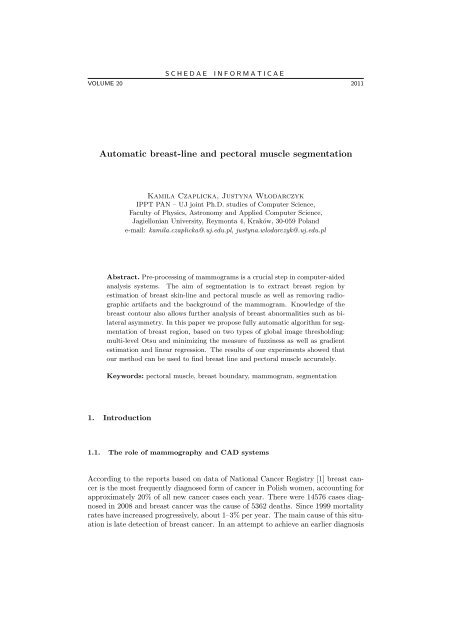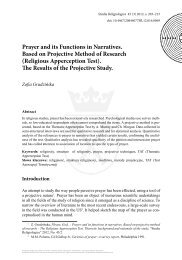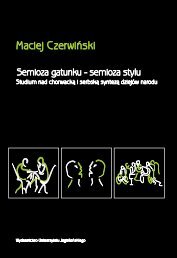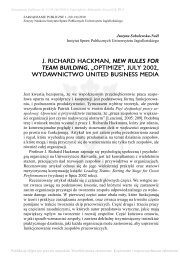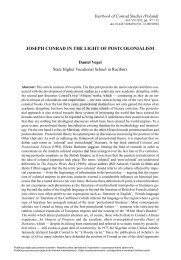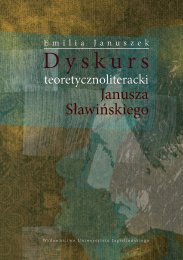Automatic breast-line and pectoral muscle segmentation
Automatic breast-line and pectoral muscle segmentation
Automatic breast-line and pectoral muscle segmentation
Create successful ePaper yourself
Turn your PDF publications into a flip-book with our unique Google optimized e-Paper software.
S C H E D A EI N F O R M A T I C A EVOLUME 20 2011<strong>Automatic</strong> <strong>breast</strong>-<strong>line</strong> <strong>and</strong> <strong>pectoral</strong> <strong>muscle</strong> <strong>segmentation</strong>Kamila Czaplicka, Justyna W̷lodarczykIPPT PAN – UJ joint Ph.D. studies of Computer Science,Faculty of Physics, Astronomy <strong>and</strong> Applied Computer Science,Jagiellonian University, Reymonta 4, Kraków, 30-059 Pol<strong>and</strong>e-mail: kamila.czaplicka@.uj.edu.pl, justyna.wlodarczyk@.uj.edu.plAbstract. Pre-processing of mammograms is a crucial step in computer-aidedanalysis systems. The aim of <strong>segmentation</strong> is to extract <strong>breast</strong> region byestimation of <strong>breast</strong> skin-<strong>line</strong> <strong>and</strong> <strong>pectoral</strong> <strong>muscle</strong> as well as removing radiographicartifacts <strong>and</strong> the background of the mammogram. Knowledge of the<strong>breast</strong> contour also allows further analysis of <strong>breast</strong> abnormalities such as bilateralasymmetry. In this paper we propose fully automatic algorithm for <strong>segmentation</strong>of <strong>breast</strong> region, based on two types of global image thresholding:multi-level Otsu <strong>and</strong> minimizing the measure of fuzziness as well as gradientestimation <strong>and</strong> <strong>line</strong>ar regression. The results of our experiments showed thatour method can be used to find <strong>breast</strong> <strong>line</strong> <strong>and</strong> <strong>pectoral</strong> <strong>muscle</strong> accurately.Keywords: <strong>pectoral</strong> <strong>muscle</strong>, <strong>breast</strong> boundary, mammogram, <strong>segmentation</strong>1. Introduction1.1. The role of mammography <strong>and</strong> CAD systemsAccording to the reports based on data of National Cancer Registry [1] <strong>breast</strong> canceris the most frequently diagnosed form of cancer in Polish women, accounting forapproximately 20% of all new cancer cases each year. There were 14576 cases diagnosedin 2008 <strong>and</strong> <strong>breast</strong> cancer was the cause of 5362 deaths. Since 1999 mortalityrates have increased progressively, about 1–3% per year. The main cause of this situationis late detection of <strong>breast</strong> cancer. In an attempt to achieve an earlier diagnosis
196Polish Ministry of Health introduced <strong>breast</strong> cancer screening, which involves mammographicscreening. Mammography is a fundamental method used in detectionof <strong>breast</strong> cancer among asymptomatic patients. The detection of an asymptomaticcancer increases cure rate significantly <strong>and</strong> reduces mortality rate by about 25% [2].Mammograms can be used to check for <strong>breast</strong> cancer not only in women who haveno signs or symptoms of the disease (screening mammogram) but also to check for<strong>breast</strong> cancer after a lump has been found (diagnostic mammogram). The X-rayimages make it possible to detect tumors (that often cannot be felt), microcalcifications(small deposits of calcium which sometimes indicate the presence of <strong>breast</strong>cancer) <strong>and</strong> architectural disturbances. Sensitivity of mammography in detectingchanges in clinically asymptomatic <strong>breast</strong> is about 93% (75–80% for dense <strong>breast</strong>)[2].A radiologist investigates mammograms for the identification (detection) of potentialabnormalities <strong>and</strong> classifies them with respect to malignancy (diagnosis).Even high quality mammograms can be misread <strong>and</strong> misinterpreted by experiencedradiologists, whose sensitivity is about 70% [2]. Mammogram misinterpretation canbe caused by the great variability in the appearance of normal <strong>and</strong> abnormal tissueas well as by so called human factor. The most common cause of wrong interpretationof mammograms is simply overlooking (caused eg by tiredness), then, on thesecond place, wrong classification of a pathology. It has been shown that an independentsecond reading of mammograms improves the sensitivity of mammographyby as much as 15% [3]. Instead of the second reading done by a physician, computersystems can be used for abnormalities detection <strong>and</strong> diagnosis (Computer-AidedDetection- CADe <strong>and</strong> Computer-Aided Diagnosis- CADi), which is often a cheaper<strong>and</strong> faster option.In this paper we propose method that can be used while image pre-processing inthe detection process.1.2. Types of mammogramsThe classical mammogram is an analog image: both coordinates of points on image<strong>and</strong> gray levels can have any values from fixed continuous ranges whereas in digitalimaging these values are quantized. Except for that <strong>and</strong> the difference in how theimage is recorded <strong>and</strong> stored, there is no other difference between the digital <strong>and</strong>analog mammography. However digital information can be enhanced, magnified, ormanipulated for further evaluation more easily than information stored on film. Inorder to receive digital mammogram three methods can be used:I. secondary digitalization of analog mammograms with using scanners (with alldrawbacks of original image, like artifacts of development process or excessive/insufficientlyexposed areas),II. indirect digital imaging (apart from classic analog mammographs it uses digitalmemory plates),
197III. direct digital imaging where an electronic image of the <strong>breast</strong> is created on thespot.In screening mammography proper mammographic examination typically involvestaking two views of the <strong>breast</strong>, from above (cranial-caudal view, CC) <strong>and</strong> from anoblique or angled view (mediolateral-oblique, MLO). With the CC view, the entire<strong>breast</strong> parenchyma (gl<strong>and</strong>ular tissue) should be depicted. With a lateral view, the<strong>pectoral</strong> (chest) <strong>muscle</strong> should be depicted as a narrow light b<strong>and</strong> on at least halfof the picture. The nipple should be depicted in profile <strong>and</strong> a clear stomach foldshould be visible under the <strong>breast</strong>. Pectoral <strong>muscle</strong> can be found on images withMLO view whereas with CC view sporadically.1.3. The aim of our workIn our work we perform <strong>breast</strong> <strong>segmentation</strong>. This task includes <strong>breast</strong> <strong>line</strong> <strong>and</strong><strong>pectoral</strong> <strong>muscle</strong> extraction as well as removing artifacts <strong>and</strong> noise. In our work wehave chosen pictures with mediolateral-obligue view, because these view is takenobligatory while screening (whereas CC view not) <strong>and</strong> the <strong>pectoral</strong> <strong>muscle</strong> can alwaysbe seen there. These kind of <strong>segmentation</strong> is important before CAD systemsstart. Their region of interest (ROI) is <strong>breast</strong> only; background artifacts (includinglabels) <strong>and</strong> <strong>pectoral</strong> <strong>muscle</strong>, which represent predominant density region, couldaffect negatively their effectiveness. The knowledge of <strong>breast</strong> contour helps to findabnormalities in <strong>breast</strong> <strong>line</strong> profile as well as it is useful in comparing images ofthe same person made over a certain amounts of time. Accurate <strong>breast</strong> skin-<strong>line</strong>detection is especially important for locating malignant lesions near the skin-<strong>line</strong>.1.4. Overview of mammogram <strong>segmentation</strong> methodsOver last three decades scientists have willingly undertaken research in <strong>breast</strong> <strong>segmentation</strong>.Traditional histogram based algorithms provided good results, but nowadaysthese methods are only first step in <strong>segmentation</strong>. They are improved bygradient methods, local histogram analysis etc. Apart from them there are newerapproaches, which have also proved their effectiveness, such as: active contours,classifiers, fuzzy-logic, polynomial modeling, wavelet decomposition, topographic approachor Markov chains. Table 1 shows selected works representing each of methodsmentioned.
198Tab. 1. Classification of methods used in <strong>breast</strong> <strong>segmentation</strong>.Method 1990’s 2000’sLau, Bischof (1991) [27]; Raba, Oliver, Marti et al.Yin, Giger, Doi et al. (1991) (2005) [5];[34]; Subashini, Ramalingam,ThresholdingAbdel-Mottaleb, Carman, Hill Palanivel (2010) [4];et al. (1996) [35];Abubaker, Aqel, Qahwaji etal. (2005) [29];Masek, Attikiouzel, deSilva(2000) [32];Mendez, Tahoces (1996) [6]; Zhou, Chan, Petrick et al.GradientKarssemeijer, Brake (1998) [9]; (2001) [7];Kwok, Ch<strong>and</strong>rasekhar,Attikiouzel (2001) [8];Ojala, Liang (1999) [25]; Liang, McInerney,Bick, Giger, Schmidt et al. Terzopoulos (2006) [12];Active(1995) [33]; Marti, Oliver, Raba et al.contours(2007) [10];Wirth, Stapinski (2003) [11];Karssemeijer (1998) [26]; Saha, Udupa (2001) [13];ClassifiersTromans, Brady, Warren(2004) [14];Fuzzy logicWirth, Nikitenko, Lyon (2005)[16];Markov chainsWang, Zhu, Deng et al. (2010)PolynomialmodelingWaveletdecompositionTopographicapproach[15];Ferrari, Rangayyan (2005)[30];Mirzaalian, Ahmadzadeh,Kolahdoozan (2006) [31];Bozek, Grgic, Mustra (2009)[36];Hong, Sohn (2010) [24];2. Proposed method2.1. Mammograms’ featuresBreasts are made up of gl<strong>and</strong>, fat <strong>and</strong> thickened (fibrous) tissue. The nature of X-rayimages has obvious limitation due to presenting 2D information of 3D objects- eachpixel on mammogram represents superposition of two or more overlapping tissues.That makes the differentiation between regions more difficult. The intensity of each
199pixel is proportional to the level of absorption X-ray by the tissues in <strong>breast</strong>- as the X-ray attenuation increases, the gray-levels in the mammogram also increase. Breastperiphery <strong>and</strong> skin-<strong>line</strong> region are less dense compared to the other neighbouringtissues so they are normally very low in gray-level contrast on mammograms <strong>and</strong>make the process of <strong>breast</strong> skin-<strong>line</strong> identification harder. In contrast, the <strong>pectoral</strong><strong>muscle</strong> is more dense <strong>and</strong> is characterized by pixels of high intensity. The backgroundis the region of low intensity pixels <strong>and</strong> low gradient.2.2. Data setAll testing images come from Pilot European Image Processing Archive (PEIPA)mini-MIAS database of mammograms [17], which is free to use in scientific researchunder the license agreement. Every of 322 pgm images in the database was digitizedat 50 micron pixel edge, reduced to 200 micron pixel edge <strong>and</strong> clipped/padded sothat every image is 1024 × 1024 pixels. MIAS database provides appropriate detailsof each image, such as character of background tissue, class, severity <strong>and</strong> imagecoordinatesof abnormality (if it is present).2.3. Algorithm detailsOur algorithm consists of four steps:I. Breast direction recognition, image trimming <strong>and</strong> reflectionII. Morphological opening of an imageIII. Pectoral <strong>muscle</strong> extractionIV. Breast skin-<strong>line</strong> estimationThe first two steps are general image pre-processing steps, whereas the last two areindeed two separate sub-algorithms for <strong>pectoral</strong> <strong>muscle</strong> extraction <strong>and</strong> <strong>breast</strong> <strong>line</strong>estimation.2.3.1. Breast direction recognition, image trimming <strong>and</strong> reflectionThe MIAS database contains images of left <strong>and</strong> right <strong>breast</strong>s, with radiologists’markers, artifacts <strong>and</strong> empty black regions (Fig. 1). Labels, artifacts <strong>and</strong> blackregions can disturb further analysis so it is better to remove them from image. Tomake images uniform <strong>and</strong> then working with them easier, it is also necessary torecognize <strong>breast</strong> direction from <strong>pectoral</strong> <strong>muscle</strong> towards nipple. In next steps we
200assume that <strong>pectoral</strong> <strong>muscle</strong> is on the top left corner of the image, so now we haveto find the side of image with <strong>pectoral</strong> <strong>muscle</strong> <strong>and</strong> reflect the image if it is needed.As it was mentioned earlier as <strong>pectoral</strong> <strong>muscle</strong> is dense, it is characterized by highintensity pixels. It is safe to assume that on mammogram <strong>pectoral</strong> <strong>muscle</strong> is thebiggest object with regular (triangular) region of similar, only high intensity pixels,that is located on the upper side of the image.Fig. 1. Example of image from MIAS databaseWe also know that unwanted black left <strong>and</strong> right borders regions consist of pixelswith zero intensity. This assumption is used while scanning through image from topto bottom, at regular <strong>line</strong> intervals (in our tests we scanned about 10% of all image<strong>line</strong>s). For each scanned <strong>line</strong> continuous ranges of close-to-zero intensity pixels onboth right <strong>and</strong> left sides are to detect. The smallest number from all border pixelsfrom the left side <strong>and</strong> the biggest number from all border pixels from the right sidedefine cut-off points for the black regions.Assumptions on <strong>pectoral</strong> <strong>muscle</strong> features are crucial in the next round of scanningwhich takes place on already trimmed image <strong>and</strong> affects all <strong>line</strong>s. In this stage foreach <strong>line</strong> we count numbers of pixels with a non-zero intensity from the left borderto the center of an image <strong>and</strong> from the center to the right border. The side withbigger number of <strong>line</strong>s with non-zero pixels ’wins’ <strong>and</strong> from now on we consider thisside as having <strong>pectoral</strong> <strong>muscle</strong>. If it is the right side, the image is reflected so as tohave <strong>pectoral</strong> <strong>muscle</strong> on its top left corner. The effect of trimming <strong>and</strong> reflecting animage is shown on Fig. 2.
201Fig. 2. Trimmed image with <strong>pectoral</strong> <strong>muscle</strong> on top-left cornerOther unnecessary elements such as markers <strong>and</strong> artifacts are removed as a sideeffectof an algorithm of extracting <strong>pectoral</strong> <strong>muscle</strong>.2.3.2. Morphological opening of an imageThe use of morphological operation of opening is st<strong>and</strong>ard procedure used for smoothingimages by removing speckle noise. In our work we applied opening with structuringelement of size 3 × 3.2.3.3. Pectoral <strong>muscle</strong> extractionOn this stage we have smoothed image with <strong>pectoral</strong> <strong>muscle</strong> on the dem<strong>and</strong>ed location<strong>and</strong> without unnecessary black regions, but still with labels <strong>and</strong> other artifactsoutside <strong>breast</strong>. The operation we make on such prepared image is multilevel thresholdingdone with multi-level Otsu (multiotsu) algorithm [18], which classifies pixelsin a number of classes based on number of gray levels (Fig. 3). We know that <strong>pectoral</strong><strong>muscle</strong> is right-angled triangle shaped, so we do not have to analyze the wholeimage, but we could cut some part of it which is on the right after the right-most
202(a) (b) (c)Fig. 3. The result of multiotsu algorithm with two thresholdshigh intensity pixels strip on the top. We start with two thresholds <strong>and</strong> increasethis number by one as long as the rest of the operations made in this steps will notbring satisfying results, definition of which will be explained later. The intentionof these proceedings is to have region with high intensity pixels containing most of<strong>pectoral</strong> <strong>muscle</strong> pixels, the other region with low intensity background pixels <strong>and</strong> atleast one intermediate region.Afterwards we take region with <strong>pectoral</strong> <strong>muscle</strong> <strong>and</strong> one of the intermediateregions with pixels of one level below (Fig. 3a <strong>and</strong> 3b). It should be the region thatis adjacent to the first with <strong>pectoral</strong> <strong>muscle</strong>. Next we compute transitional areabetween that two regions. If this area contains certain percentage of black pixelsit is considered that the second region is useless for further calculations <strong>and</strong> themultiotsu algorithm is restarted with a greater number of thresholds. On the othercase (as on Fig. 3a <strong>and</strong> 3b) we assume that chosen area contains the border between<strong>pectoral</strong> <strong>muscle</strong> <strong>and</strong> the <strong>breast</strong>.We calculate hypothetical coordinates of this border by applying gradient operatorput together with some adjustment calculations (eg we ignore points which aretoo far from sequence of points previously recognized as border points, Fig. 4a).
203Having border points we use <strong>line</strong>ar regression to smooth the <strong>line</strong> formed by chosenpoints- the resultant polynomial is acknowledged as a border of <strong>pectoral</strong> <strong>muscle</strong> (Fig.4b).(a)(b)Fig. 4. Border points <strong>and</strong> result of <strong>line</strong>ar regression on trimmed imageAs it was mentioned earlier labels <strong>and</strong> other artifacts are removed on the occasionof previous operations. Indeed, after multiotsu algorithm we have image with regionof low intensity pixels containing background <strong>and</strong> skin-air interface. Again if wecompute gradient on this image we will estimate approximate <strong>breast</strong> border. Thenif we subtract everything on the image which is on the right from this rough borderwe will get image with labels <strong>and</strong> artifacts removed (Fig. 5).2.3.4. Breast skin-<strong>line</strong> estimationDetection of the <strong>breast</strong> border is a two-stage process based on a combination ofimage binarization <strong>and</strong> edge detection. In the first stage we use a global thresholdingmethod based on minimizing measures of fuzziness of an input mammogram,
204(a)(b)Fig. 5. Image after removing artifactsdescribed by Huang, Wang [19]. After this step we have image that is a collectionof two regions: background <strong>and</strong> the union of <strong>breast</strong> <strong>and</strong> <strong>pectoral</strong> <strong>muscle</strong> (Fig. 6a).In the final step we apply the Sobel method to find edges using the Sobel approximationto the derivative. It returns edges at those points where the gradient ofhorizontal <strong>and</strong> vertical measure is maximum (Fig. 6b). These edges are assumed as<strong>breast</strong> skin-<strong>line</strong> estimation.3. ResultsOur algorithm was tested on 300 selected mammograms from the mini-MIAS database.Each analyzed image was examined by experienced radiologist who classifiedan image to one of two categories: correctly segmented or incorrectly segmented.Then the efficiency of our algorithm was evaluated by measuring the total percentageerror (TPE) expressed as a percentage quotient of the number of incorrectlysegmented images <strong>and</strong> the total number of images:
205(a)(b)Fig. 6. Breast skin-<strong>line</strong> estimationTPE =number of incorrectly segmented images100%number of all imagesThe algorithm proved its effectiveness achieving 1% level of TPE rate. Thecorrectness of the estimation separately for <strong>breast</strong> <strong>line</strong> <strong>and</strong> <strong>pectoral</strong> <strong>muscle</strong> was onthe level of 99% <strong>and</strong> 98% respectively. Artifacts were properly removed for nearly100% images.The results obtained by proposed method indicate that it can overcome limitationsof existing methods such us:I. over-<strong>segmentation</strong> or under-<strong>segmentation</strong> of <strong>breast</strong> region or <strong>pectoral</strong> <strong>muscle</strong>region in case of fuzzy boundary between the <strong>muscle</strong> <strong>and</strong> the tissue [5] (Fig. 7a, b, c, d, e),II. erroneous detection of <strong>pectoral</strong> <strong>muscle</strong> when:• <strong>pectoral</strong> <strong>muscle</strong> boundary is a curve (ie is not close to straight <strong>line</strong>) [20](Fig. 7a),• the intensities of <strong>muscle</strong> region change greatly [21] (Fig. 7b),
206• the area of <strong>pectoral</strong> <strong>muscle</strong> in comparison with <strong>breast</strong> area is larger (Fig.7c) or smaller (Fig. 7e) than typically [23],• <strong>pectoral</strong> <strong>muscle</strong> (seems to) consists of several layers [22] (Fig. 7 a, b).(a) (b) (c)(d)(e)Fig. 7. Results of <strong>pectoral</strong> <strong>muscle</strong> extraction on a selection of non-st<strong>and</strong>ard <strong>muscle</strong>s
2074. Concluding remarksThe results of our experiments showed that described algorithm is characterized byhigh efficiency- total percentage error was equal to approximately 1%. In comparisonwith algorithms described in literature [5, 10, 11, 15], where effectiveness rangedfrom 95% to 97%, the accuracy of our method is higher by about 2%. The approachpresented for <strong>breast</strong> <strong>segmentation</strong> is among the most effective algorithms <strong>and</strong> ourresults are similar to the best algorithms described [16, 28]. Proposed method canalmost completely eliminate the possibility of wrong detection of <strong>pectoral</strong> <strong>muscle</strong>region <strong>and</strong> <strong>breast</strong> skin-<strong>line</strong>. In this context, our fully automatic algorithm for <strong>breast</strong><strong>segmentation</strong> in mammograms can be used as a first processing step in other medicalimage applications that enable detection of abnormal areas of density, mass orcalcification which may indicate the presence of cancer.5. References[1] National Cancer Registry. Available via http://epid.coi.waw.pl/krn.[2] Dziukowa J., Weso̷lowska E.; Mammografia w diagnostyce raka sutka, MediPage,Warszawa, 2006.[3] Wirth M.A., Stapinski A.; Segmentation of the <strong>breast</strong> region in mammograms usingactive contours, 1st Canadian Conference on Computer <strong>and</strong> Robot Vision, 2004, pp.385–392.[4] Subashini T.S., Ramalingam V., Palanivel S.; Pectoral Muscle removal <strong>and</strong> Detectionof masses in Digital Mammogram using CCL, International Journal of ComputerApplications, 1(6), 2010, pp. 66–70.[5] Raba D., Oliver A., Marti J., Peracaula M. et al.; Breast Segmentation with PectoralMuscle Suppression on Digital Mammograms, Pattern Recognition <strong>and</strong> ImageAnalysis, Springer, 3523, 2005, pp. 471–478.[6] Mendez A., Tahoces P., Lado M.J. et al.; <strong>Automatic</strong> detection of <strong>breast</strong> border <strong>and</strong> nipplein digital mammograms, Computer methods <strong>and</strong> programs in biomedicine, 49(3),1996, pp. 253–262.[7] Zhou C., Chan H.P., Petrick N. et al.; Computerized image analysis: estimation of<strong>breast</strong> density on mammograms, Medical Physics, 28(6), 2001, pp. 1056–1069.[8] Kwok S.M., Ch<strong>and</strong>rasekhar R., Attikiouzel Y.; <strong>Automatic</strong> <strong>pectoral</strong> <strong>muscle</strong> <strong>segmentation</strong>on mammograms by straight <strong>line</strong> estimation <strong>and</strong> cliff detection, Proceedings ofthe Seventh Australian <strong>and</strong> New Zeal<strong>and</strong> Intelligent Information Systems Conference,2001, pp. 67–72.
208[9] Karssemeijer N., Brake G.; Combining single view features <strong>and</strong> asymmetry for detectionof mass lesions, 4th International Workshop on Digital Mammography, 1998.[10] Marti R., Oliver A., Raba D. et al.; Breast Skin-Line Segmentation Using ContourGrowing, Pattern Recognition <strong>and</strong> Image Analysis, Lecture Notes in Computer Science,4478/2007, 2007, pp. 564–571.[11] Wirth M.A., Stapinski A.; Segmentation of the <strong>breast</strong> region in mammograms usingactive contours, Visual Communications <strong>and</strong> Image Processing, 5150, 1995, pp. 1995–2006.[12] Liang J., McInerney T., Terzopoulos D.; United Snakes, Medical Image Analysis, 10,2006, pp. 215–233.[13] Saha P., Udupa J.; Breast tissue density quantification via digitized mammograms,IEEE Transactions on Medical Imaging, 20, 2001, pp. 792–803.[14] Tromans C., Brady J., Warren R.; A high accuracy technique for <strong>breast</strong> air boundary<strong>segmentation</strong> <strong>and</strong> the resulting improvement from its use in <strong>breast</strong> density estimation,International Workshop on Digital Mammography, 2004, pp. 17–18.[15] Wang L., Zhu M., Deng L. et al.; <strong>Automatic</strong> <strong>pectoral</strong> <strong>muscle</strong> boundary detection inmammograms based on Markov chain <strong>and</strong> active contour model, Journal of ZhejiangUniversity-SCIENCE C (Computers & Electronics), 11(2), 2010, pp. 111–118.[16] Wirth M., Nikitenko D., Lyon J.; Segmentation of the Breast Region in Mammogramsusing a Rule-Based Fuzzy Reasoning Algorithm, ICGST International Journalon Graphics, Vision <strong>and</strong> Image Processing, 5(2), 2005, pp. 45–54.[17] Pilot European Image Processing Archive’s database of mammograms. Available viahttp://peipa.essex.ac.uk/info/mias.html.[18] Liao P.S., Chen T.S., Chung P.C.; A fast algorithm for multilevel thresholding, Journalof Information Science <strong>and</strong> Engineering, 17(5), 2001, pp. 713–727.[19] Huang L.-K., Wang M.-J. J.; Image Thresholding by Minimizing the Measures ofFuzziness, Pattern Recognition, 28(1), 1995, pp. 41–51.[20] Kinoshita S.K., Azevedo-Marques P.M., Pereira R.R. et al.; Radon-Domain Detectionof the Nipple <strong>and</strong> the Pectoral Muscle in Mammograms, Journal of Digital Imaging,21(1), 2007, pp. 37–49.[21] Hong B., Brady M.; A Topographic Representation for Mammogram Segmentation,Medical Image Computing <strong>and</strong> Computer-Assisted Intervention, 2, 2003, pp. 730–737.[22] Carvalho I.M., Luz L.M.S., Alvarenga A.V. et al.; An <strong>Automatic</strong> Method for De<strong>line</strong>atingthe Pectoral Muscle in Mammograms, IFMBE Proceedings, 18(2), 2008, pp.271–275.[23] Xu W.D., Li L.H., Liu W.; A Novel Pectoral Muscle Segmentation Algorithm Basedon Poly<strong>line</strong> Fitting <strong>and</strong> Elastic Thread Approaching, The 1st International Conferenceon Bioinformatics <strong>and</strong> Biomedical Engineering, 2007, pp. 837–840.[24] Hong B.W., Sohn B.S.; Segmentation of Regions of Interest in Mammograms in aTopographic Approach, IEEE Transactions on Information Technology in Biomedicine,14(1), 2010, pp. 129–139.
209[25] Ojala T., Liang J.; Interactive <strong>segmentation</strong> of the <strong>breast</strong> region from digitized mammogramswith united snakes, Technical Report 315, Turku Centre for Computer Science,1999.[26] Karssemeijer N.; Automated classification of parenchymal patterns in mammograms,Physics in Medicine <strong>and</strong> Biology, 43(2), 1998.[27] Lau T., Bischof W.F.; Automated Detection of Breat Tumors Using the AssymetryApproach, Computers <strong>and</strong> Biomedical Research, 24, 1991, pp. 273–295.[28] Yapa R.D., Harada K.; Breast Skin-Line Estimation <strong>and</strong> Breast Segmentation in Mammogramsusing Fast-Marching Method, International Journal of Biological <strong>and</strong> LifeSciences, 3(1), 2007.[29] Abubaker A., Aqel M., Qahwaji R. et al.; Average Row Thresholding Method forMammogram Segmentation, The 27th Annual International Conference of the IEEEEngineering in Medicine <strong>and</strong> Biology Society, 2005, pp. 3288–3291.[30] Ferrari R., Rangayyan R.; <strong>Automatic</strong> identification of the <strong>pectoral</strong> <strong>muscle</strong> in mammograms,IEEE Transactions on Medical Imaging, 23, 2004, pp. 232–245.[31] Mirzaalian H., Ahmadzadeh M.R., Kolahdoozan F.; Breast Contour Detection onDigital Mammogram, Proceedings of 2nd International Conference on Information &Communication Technologies: from Theory to Applications, 2006, pp. 1804–1808.[32] Masek M., Attikiouzel Y., deSilva C.J.S.; Skin-air interface extraction from mammogramsusing an automatic local thresholding algorithm, 15th Biennial InternationalConference Biosignal, 2000, pp. 204–206.[33] Bick U., Giger M.L., Schmidt R.A. et al.; Automated <strong>segmentation</strong> of digitized mammograms,Academic Radiology, 2, 1995, pp. 1–9.[34] Yin F., Giger M.L., Doi K. et al.; Computerized detection of masses in digital mammograms:analysis of bilateral subtraction images, Medical Physics, 18(5), 1991, pp.955–963.[35] Abdel-Mottaleb M., Carman C.S., Hill C.R. et al.; Locating the boundary betweenthe <strong>breast</strong> skin edge <strong>and</strong> the background in digitized mammograms, 3rd InternationalWorkshop on Digital Mammography, 98, 1996, pp. 467–470.[36] Bozek J., Grgic M., Mustra M.; Breast border extraction <strong>and</strong> <strong>pectoral</strong> <strong>muscle</strong> detectionusing wavelet decomposition, Proceedings of the International IEEE ConferenceEUROCON, 2009, pp. 1426–1433.Received April 16, 2010


